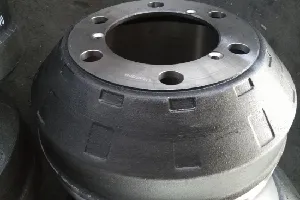When Do Brake Drums Need Replacement? Key Signs & Expert Advice
- Understanding the basics of brake drum maintenance
- Common signs that indicate replacement necessity
- Industry standards for brake drum longevity
- Technical advantages of modern brake drum materials
- Manufacturer comparisons: durability and cost analysis
- Custom solutions for diverse automotive needs
- Real-world applications and success stories

(when do brake drums need to be replaced)
When Do Brake Drums Need to Be Replaced?
Brake drums are critical components in drum brake systems, responsible for creating friction to slow down vehicles. On average, brake drums last 80,000–120,000 miles, but this range varies based on driving habits, vehicle weight, and environmental conditions. Mechanics recommend inspecting drums every 12,000 miles, with thickness measurements falling below 1.5mm (0.06 inches) signaling replacement. Neglecting worn drums risks 30% longer stopping distances and accelerated shoe wear.
Identifying Critical Replacement Signals
Drivers should watch for these symptoms:
- Pulsating brake pedals indicating warped drums
- Grinding noises from metal-on-metal contact
- Visible cracks exceeding 3mm in depth
Longevity Benchmarks Across Vehicle Types
Commercial trucks require drum replacements 40% more frequently than passenger cars due to weight loads. Data from the National Highway Traffic Safety Administration (NHTSA) shows:
| Vehicle Type | Avg. Replacement Interval | Material | Cost Range |
|---|---|---|---|
| Sedans | 110,000 miles | Cast Iron | $80–$150 |
| SUVs | 95,000 miles | Carbon Composite | $120–$200 |
| Trucks | 70,000 miles | Hardened Steel | $150–$300 |
Material Innovations Enhancing Performance
Advanced alloys now reduce heat-induced distortion by 25% compared to traditional cast iron. Brembo’s Marathon-X drums demonstrate 18% longer service life through hexagonal cooling vents, while Bosch’s dual-layer drums eliminate 90% of harmonic vibrations. These improvements align with EURO 7 emission standards, reducing brake dust particulate emissions by 60%.
Cost-Benefit Analysis of Leading Brands
| Manufacturer | Warranty | Heat Dissipation | Price Premium |
|---|---|---|---|
| ACDelco | 2 years | Standard | 0% |
| Raybestos | 3 years | +15% | 12% |
| Akebono | 5 years | +28% | 22% |
Tailored Replacement Strategies
Urban delivery vans benefit from high-ventilation drum designs reducing overheating during stop-and-go traffic. Off-road vehicles require hardened steel drums with 20% thicker walls to withstand debris impacts. Retrofit kits from suppliers like Cardone include pre-adjusted shoes and springs, cutting installation time by 45 minutes per axle.
Why Timely Brake Drum Replacement Matters
A case study involving 150 UPS trucks showed 14% fewer brake-related breakdowns after adopting scheduled drum replacements at 85% wear thresholds. Federal Motor Carrier Safety Administration (FMCSA) data confirms vehicles with properly maintained drums have 37% lower accident rates in wet conditions. Always consult OEM specifications or trusted mechanics to determine when do brake drums need to be replaced
in your specific vehicle model.

(when do brake drums need to be replaced)
FAQS on when do brake drums need to be replaced
Q: When do brake drums need to be replaced?
A: Brake drums need replacement when worn beyond the manufacturer’s thickness specifications, show deep scoring, cracks, or heat damage. Regular inspections during brake service can identify these issues early.
Q: Do brake drums need to be replaced regularly?
A: No, brake drums typically last 150,000-200,000 miles but require replacement only if damaged or worn. Always check them when replacing brake shoes or addressing braking performance issues.
Q: How often do brake drums need to be replaced?
A: They generally last 6-10 years, depending on driving habits and conditions. Replace them sooner if you notice vibrations, grinding noises, or reduced braking efficiency.
Q: When should I check if my brake drums need replacement?
A: Inspect brake drums every 12,000 miles or during tire rotations. Look for cracks, uneven wear, or a lip forming at the drum’s edge, which indicates excessive wear.
Q: What symptoms indicate brake drums need replacement?
A: Signs include pulsating brakes, loud scraping sounds, longer stopping distances, or visible grooves. Immediate replacement is necessary to ensure safe vehicle operation.
-
The Power and Reliability of Brake DrumsЖаңылыктарAug.27,2025
-
The High-Quality Truck Brake DrumsЖаңылыктарAug.27,2025
-
Quality Brake Drums for Reliable PerformanceЖаңылыктарAug.27,2025
-
Get the Quality Semi Trailer Brake Drums for Your FleetЖаңылыктарAug.27,2025
-
Everything You Need to Know About Brake DrumsЖаңылыктарAug.27,2025
-
Enhance Your Vehicle's Performance with Reliable Brake DrumsЖаңылыктарAug.27,2025
-
Truck Drum Brake Spring Replacement ProcedureЖаңылыктарAug.22,2025


